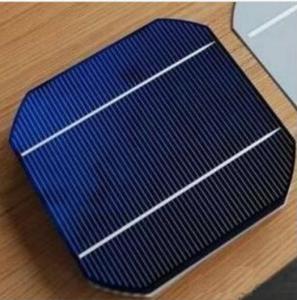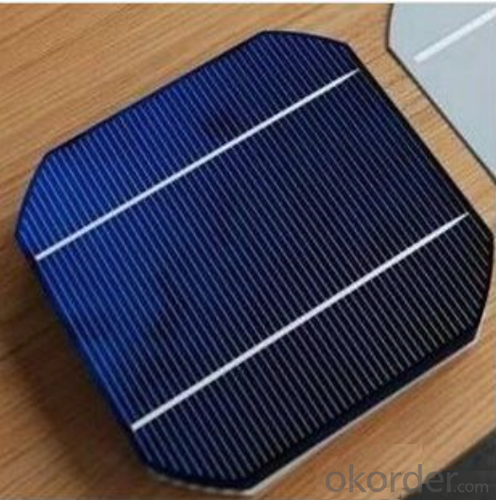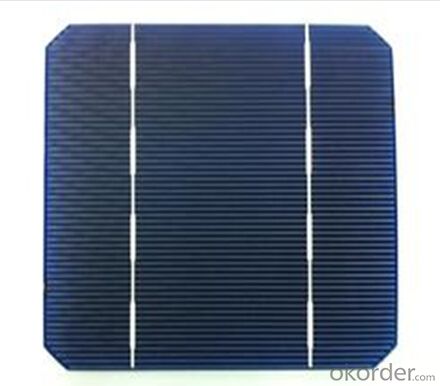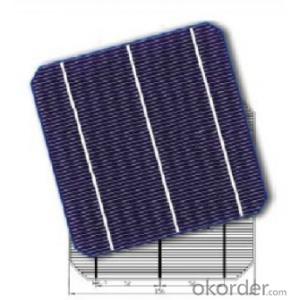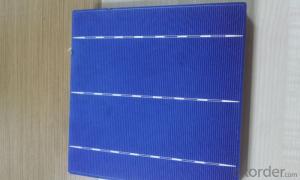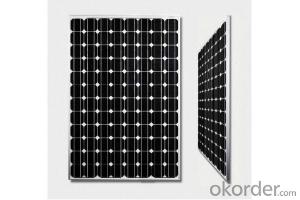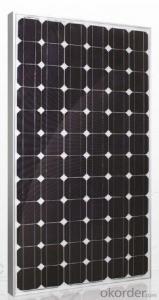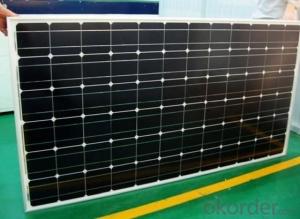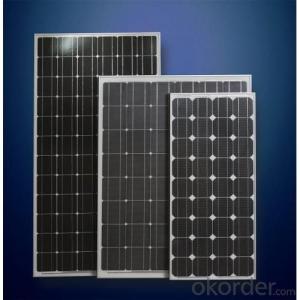Monocrystalline Solar Cell for Solar PV Panel
- Loading Port:
- China main port
- Payment Terms:
- TT or LC
- Min Order Qty:
- 10000 watt
- Supply Capability:
- 10000000 watt/month
OKorder Service Pledge
OKorder Financial Service
You Might Also Like
1. Structure of Monocrystalline Solar Cell for Solar PV Panel Description
A solar cell, or photovoltaic cell, is an electrical device that converts the energy of light directly into electricity by the photovoltaic effect,
which is a physical and chemical phenomenon. It is a form of photoelectric cell, defined as a device whose electrical characteristics, such
as current, voltage, or resistance, vary when exposed to light. Solar cells are the building blocks of photovoltaic modules, otherwise known
as solar panels.
2. Main Features of the Monocrystalline Solar Cell for Solar PV Panel
• High module conversion efficiency, through superior manufacturing technology
• 0 to +5W positive tolerance for mainstream products
• Certified to withstand high wind loads and snow loads
• Anodized aluminum is mainly for improving corrosion resistance
• Anti-reflective, Highly transparent, low iron tempered glass
• Excellent performance under low light environment
3. Monocrystalline Solar Cell for Solar PV Panel Images
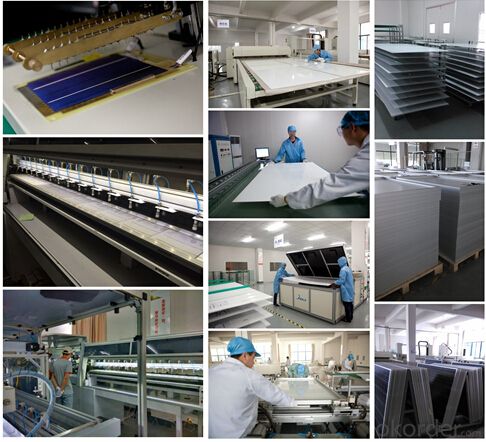
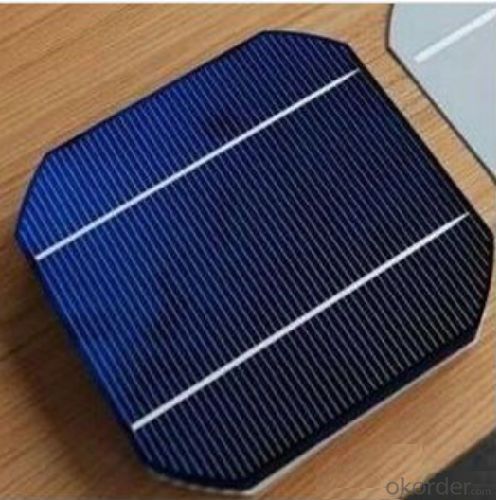
4. Monocrystalline Solar Cell for Solar PV Panel Specification
窗体顶端 Solar Cell 窗体底端 | Mono-crystalline silicon 125 × 125 mm ( 5 inches ) |
No. of Cells | 72 (6× 12) |
Dimensions | 1580 × 808 × 35mm |
Weight | 15.5 kgs |
Front | Glass 3.2 mm tempered glass |
Frame | Anodized aluminium alloy |
Junction Box | IP67 / IP65 rated (3 bypass diodes) |
Output Cables | TUV (2Pfg1169:2007), UL 4703, UL4703 ,4.0 mm2, symmetrical lengths |
(-) 900mm and (+) 900 mm | |
Connectors | MC4 compatible |
Mechanical load test | 5400Pa |
Resistance | 277g steel ball falls down from 1m height and 60m/s wind |
窗体顶端 Temperature Characteristics 窗体底端 | |
Nominal Operating Cell Temperature (NOCT) | 45±2°C |
Temperature Coefficient of Pmax | -0.44 %/°C |
Temperature Coefficient of Voc | -0.33 %/°C |
Temperature Coefficient of Isc | 0.055 %/°C |
5. FAQ of Monocrystalline Solar Cell for Solar PV Panel
Q1. How long can we receive the product after purchase?
A1.In the purchase of product within three working days, We will arrange the factory delivery as soon as possible. The pecific time of
receiving is related to the state and position of customers
Q2. Can we visit your factory?
A2:Surely, I will arrange the trip basing on your business schedule.
Q3:Which payment terms can you accept?
A3:T/T,L/C,Moneygram,Paypal are available for us.
Basic procedure of the working about solar cells
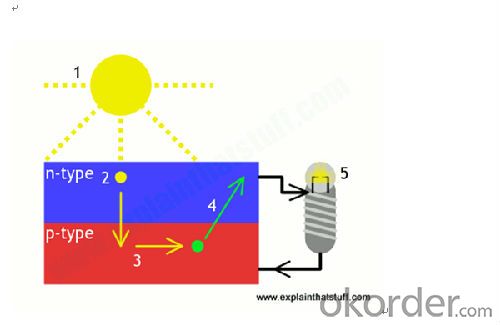
A solar cell is a sandwich of n-type silicon (blue) and p-type silicon (red). It generates electricity by using sunlight to make electrons hop across the junction between the different flavors of silicon:
When sunlight shines on the cell, photons (light particles) bombard the upper surface.
The photons (yellow blobs) carry their energy down through the cell.
The photons give up their energy to electrons (green blobs) in the lower, p-type layer.
The electrons use this energy to jump across the barrier into the upper, n-type layer and escape out into the circuit.
Flowing around the circuit, the electrons make the lamp light up.
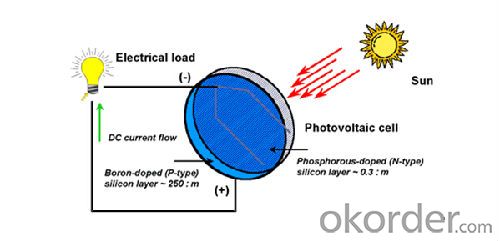
Working of PV cells
A typical silicon PV cell is composed of a thin wafer consisting of an ultra-thin layer of phosphorus-doped (N-type) silicon on top of a thicker layer of boron-doped (P-type) silicon. An electrical field is created near the top surface of the cell where these two materials are in contact, called the P-N junction. When sunlight strikes the surface of a PV cell, this electrical field provides momentum and direction to light-stimulated electrons, resulting in a flow of current when the solar cell is connected to an electrical load
- Q: How do solar cells perform in regions with high levels of salt spray and corrosive environments?
- Solar cells can be affected by salt spray and corrosive environments, which can degrade their performance over time. The exposure to high levels of salt spray can lead to corrosion of the cell's components, such as the metallic contacts, leading to a decrease in efficiency. However, manufacturers have developed various protective coatings and materials to mitigate the effects of salt spray and corrosion, ensuring the long-term performance of solar cells in such challenging environments.
- Q: What is the difference between solar cells and solar panels?
- Solar cells and solar panels are closely related but have some key differences. A solar cell refers to a single unit that converts sunlight into electricity through the photovoltaic effect. It is the basic building block of a solar panel. On the other hand, a solar panel, also known as a photovoltaic module, is made up of multiple interconnected solar cells. The purpose of a solar panel is to harness a larger amount of sunlight and generate a higher output of electricity. In summary, while a solar cell is the individual component that directly converts sunlight into electricity, a solar panel is a collection of interconnected solar cells that work together to produce a higher power output.
- Q: My son is very interested in solar cells recently, and keeps asking me about the structure of a solar cell. Can anybody help me answer that question?
- Here is what I found from my chemistry teacher: The basic component of a solar cell is pure silicon, which is not pure in its natural state.
- Q: How long do solar cells last?
- Solar cells typically have a lifespan of around 25 to 30 years, but with proper maintenance and care, they can continue producing electricity for even longer.
- Q: Can solar cells be used in harsh climates?
- Yes, solar cells can be used in harsh climates. While extreme temperatures, snow, and dust can potentially affect the efficiency and performance of solar cells, advancements in technology and design have made them more resilient. Specialized coatings, materials, and mounting systems are employed to protect solar cells from harsh weather conditions. In fact, solar panels are increasingly being used in various extreme climates around the world, including deserts and polar regions, proving their adaptability and effectiveness even in challenging environments.
- Q: What is the impact of leaf litter on solar cell performance?
- Leaf litter can have a negative impact on solar cell performance as it can block sunlight from reaching the cells, reducing their efficiency. Additionally, if the litter accumulates and covers the cells, it can hinder their ability to convert light into electricity. Regular cleaning and maintenance are essential to ensure optimal solar cell performance.
- Q: Can solar cells be used to power electronic devices?
- Yes, solar cells can be used to power electronic devices. Solar cells convert sunlight into electricity, which can then be used to power various electronic devices such as calculators, smartphones, and even larger appliances like laptops or refrigerators when appropriately connected to the solar cell system.
- Q: What is the role of solar cells in powering off-grid cabins?
- Solar cells play a crucial role in powering off-grid cabins by harnessing sunlight and converting it into electricity. These cells, also known as photovoltaic cells, generate renewable energy that can be stored in batteries for later use. This sustainable power source eliminates the need for traditional electricity grids, allowing off-grid cabins to be completely self-sufficient.
- Q: Can solar cells be used in indoor applications?
- Yes, solar cells can be used in indoor applications, although their efficiency may be lower compared to outdoor use. Indoor applications typically include powering small electronic devices or providing lighting for indoor spaces.
- Q: How can I calculate the cost of using solar cells if I put a fully-functional solar system in my house?
- The installation is more expensive than using it.
Send your message to us
Monocrystalline Solar Cell for Solar PV Panel
- Loading Port:
- China main port
- Payment Terms:
- TT or LC
- Min Order Qty:
- 10000 watt
- Supply Capability:
- 10000000 watt/month
OKorder Service Pledge
OKorder Financial Service
Similar products
Hot products
Hot Searches
Related keywords
